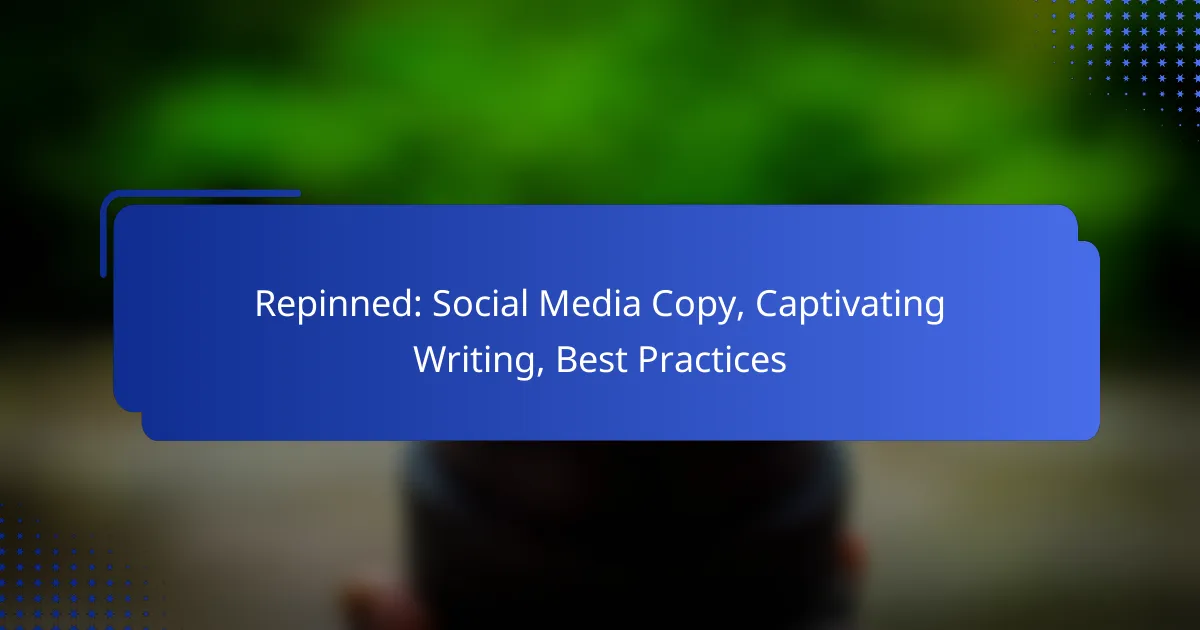Creating captivating social media copy requires a focus on clarity, engagement, and relevance to your audience. By employing effective writing techniques and best practices, you can significantly enhance your brand’s online presence and foster meaningful interactions. Measuring the success of your content through engagement and conversion metrics will help refine your approach and drive desired actions.
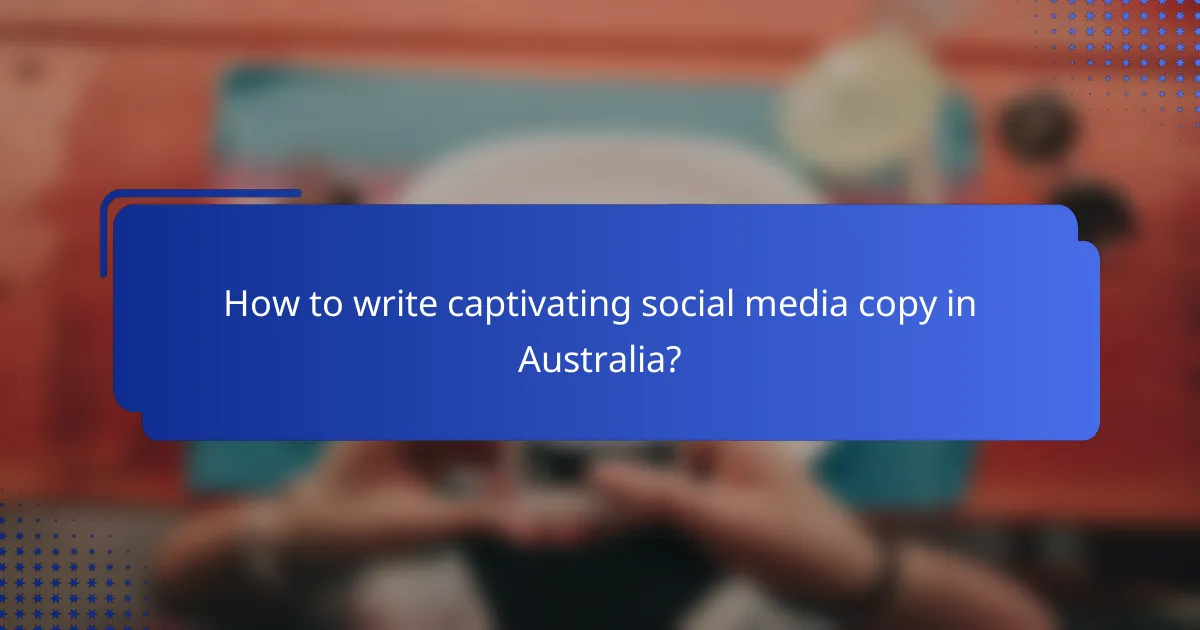
How to write captivating social media copy in Australia?
To write captivating social media copy in Australia, focus on clarity, engagement, and relevance to the local audience. Use language that resonates with Australians while addressing their interests and concerns.
Use engaging language
Engaging language grabs attention and encourages interaction. Use action verbs, vivid adjectives, and concise sentences to create a sense of urgency or excitement. For example, instead of saying “Check out our new product,” try “Discover your new favorite gadget today!”
Keep your tone conversational and approachable. This helps build a connection with your audience, making them more likely to engage with your content.
Incorporate local slang
Incorporating local slang can make your social media copy feel more relatable and authentic to an Australian audience. Use terms like “arvo” for afternoon or “bikkie” for biscuit to create familiarity.
However, be cautious not to overdo it. Use slang sparingly and ensure it fits the context of your message to avoid confusion or alienation.
Utilize storytelling techniques
Storytelling can transform your social media copy into a compelling narrative that resonates with your audience. Share customer experiences, brand journeys, or relatable anecdotes that highlight your message.
Consider using a three-part structure: setup, conflict, and resolution. This approach keeps readers engaged and encourages them to connect emotionally with your brand.
Focus on audience pain points
Addressing audience pain points in your social media copy shows that you understand their challenges. Identify common issues your target audience faces and present your product or service as a solution.
Use direct language that speaks to their needs. For instance, instead of saying “Our service is great,” you might say “Tired of waiting hours for customer support? Our team is here to help you instantly!”
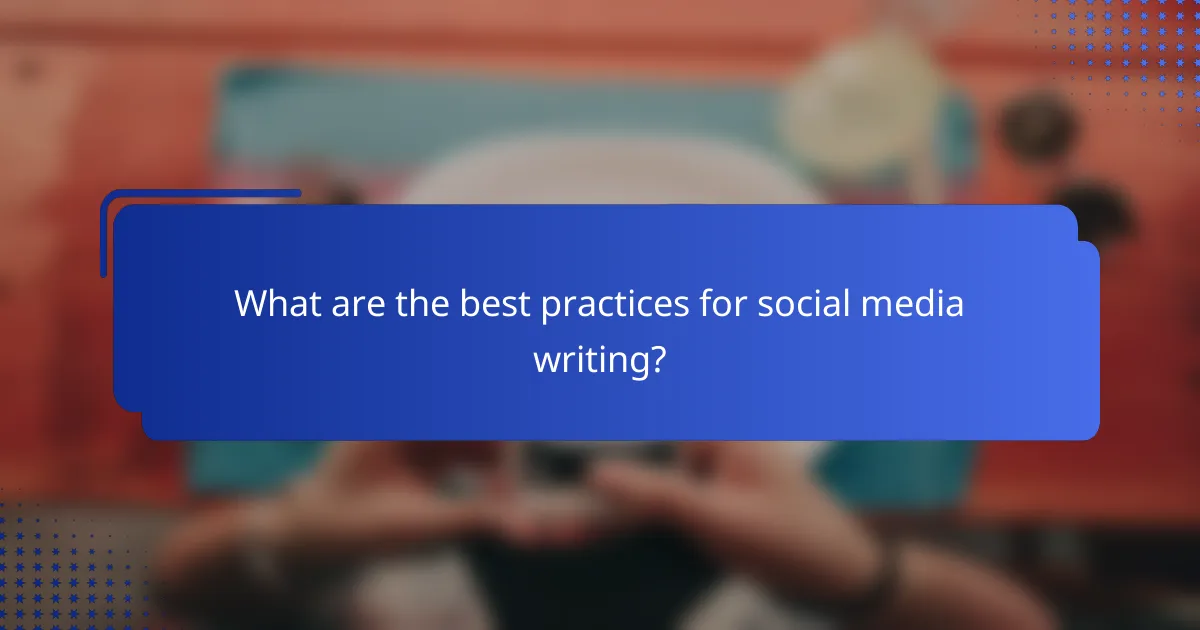
What are the best practices for social media writing?
Effective social media writing involves clear communication, engaging content, and strategic planning. By following best practices, you can enhance your brand’s online presence and foster meaningful interactions with your audience.
Maintain a consistent brand voice
A consistent brand voice helps establish your identity and builds trust with your audience. This voice should reflect your brand’s values and personality, whether it’s professional, casual, humorous, or inspirational.
To maintain consistency, create a style guide that outlines tone, language, and key messaging. Regularly review your posts to ensure they align with this guide, and train your team on these standards to avoid mixed messages.
Include clear calls to action
Clear calls to action (CTAs) guide your audience on what to do next, whether it’s visiting your website, signing up for a newsletter, or sharing your content. Effective CTAs are concise, direct, and relevant to the post’s content.
Use action-oriented language and create a sense of urgency when appropriate. For example, phrases like “Join now,” “Limited time offer,” or “Download today” can encourage immediate responses from your audience.
Optimize for each platform
Each social media platform has its unique audience and content style, so optimizing your writing for each is crucial. Tailor your message to fit the platform’s character limit, preferred formats, and user behavior.
For instance, use hashtags effectively on Twitter and Instagram, while focusing on longer, more detailed posts on Facebook or LinkedIn. Familiarize yourself with the best practices for each platform to maximize engagement and reach.
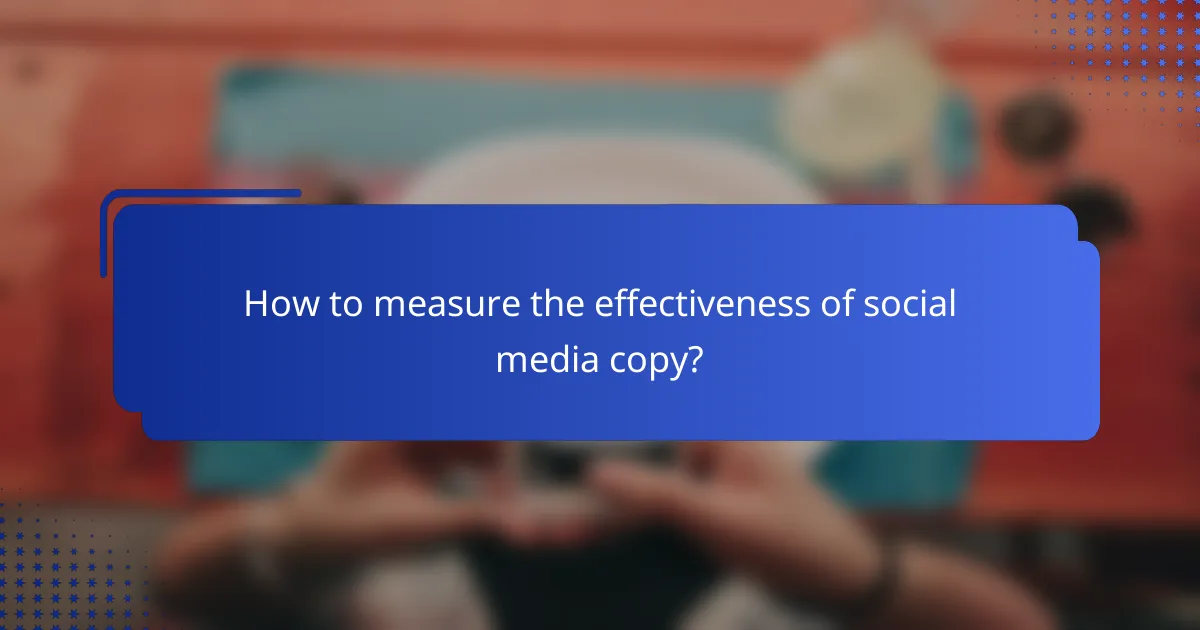
How to measure the effectiveness of social media copy?
Measuring the effectiveness of social media copy involves assessing how well your content engages your audience and drives desired actions. Key metrics include engagement rates, conversion rates, and the results from testing different copy variations.
Track engagement metrics
Engagement metrics are vital for understanding how your audience interacts with your social media copy. Key metrics include likes, shares, comments, and click-through rates. Aim for engagement rates that fall within the range of 1% to 5% for most platforms, as this indicates a healthy level of interaction.
To track these metrics, utilize the analytics tools provided by social media platforms. Regularly review these insights to identify trends and adjust your copy accordingly. High engagement often signifies that your messaging resonates with your audience.
Analyze conversion rates
Conversion rates measure how effectively your social media copy prompts users to take specific actions, such as signing up for a newsletter or making a purchase. A good conversion rate generally ranges from 2% to 5%, though this can vary by industry and platform.
To analyze conversion rates, set clear goals for each campaign and use tracking links to monitor performance. Tools like Google Analytics can help you attribute conversions to specific social media efforts. Focus on optimizing your copy to highlight benefits and create a sense of urgency to improve these rates.
Utilize A/B testing
A/B testing involves comparing two versions of your social media copy to determine which performs better. This method allows you to test different headlines, calls to action, or even images to see what resonates most with your audience.
When conducting A/B tests, ensure you test one variable at a time for clear results. Use a sample size that is statistically significant to draw reliable conclusions. Aim for a testing period of at least a week to gather enough data before making decisions based on the results.

What tools can enhance social media writing?
Several tools can significantly improve social media writing by enhancing visual appeal, streamlining scheduling, and ensuring grammatical accuracy. Utilizing these tools can lead to more engaging content and efficient management of social media platforms.
Canva for visual content
Canva is a user-friendly design tool that allows users to create eye-catching graphics for social media posts. With a wide range of templates tailored for various platforms, it simplifies the design process, making it accessible even for those without a design background.
When using Canva, focus on maintaining brand consistency by using similar colors, fonts, and styles across your visuals. This helps in building brand recognition and trust among your audience.
Hootsuite for scheduling
Hootsuite is a powerful social media management tool that enables users to schedule posts across multiple platforms in advance. This feature allows for consistent posting, even during busy periods, ensuring that your audience remains engaged.
To maximize Hootsuite’s effectiveness, analyze your audience’s online activity to determine optimal posting times. Regularly review engagement metrics to adjust your strategy and improve post performance.
Grammarly for proofreading
Grammarly is an essential tool for proofreading social media copy, helping to catch grammatical errors and improve overall clarity. It offers real-time suggestions for enhancing writing style, tone, and readability, which is crucial for maintaining professionalism online.
When using Grammarly, pay attention to its tone adjustments to ensure your writing aligns with your brand voice. Regularly proofreading your content can prevent miscommunication and enhance audience trust.

What are common mistakes in social media copy?
Common mistakes in social media copy include overloading with information, neglecting audience research, and ignoring platform guidelines. These errors can lead to ineffective communication and reduced engagement with your audience.
Overloading with information
Overloading your social media copy with excessive information can overwhelm your audience and dilute your message. Aim for clarity and brevity, focusing on one key idea or call to action per post.
For example, instead of listing every feature of a product, highlight the top two or three benefits that resonate most with your audience. This approach keeps your copy engaging and easier to digest.
Neglecting audience research
Neglecting audience research can result in content that fails to connect with your target demographic. Understanding your audience’s preferences, interests, and pain points is crucial for crafting relevant and appealing messages.
Utilize tools like surveys or social media analytics to gather insights about your followers. Tailoring your copy to reflect their needs can significantly enhance engagement and response rates.
Ignoring platform guidelines
Ignoring platform guidelines can lead to posts that are ineffective or even removed. Each social media platform has its own best practices regarding character limits, image sizes, and content types.
For instance, Twitter has a character limit of 280, while Instagram emphasizes visual content. Familiarize yourself with these guidelines to ensure your copy is optimized for each platform, enhancing visibility and interaction.
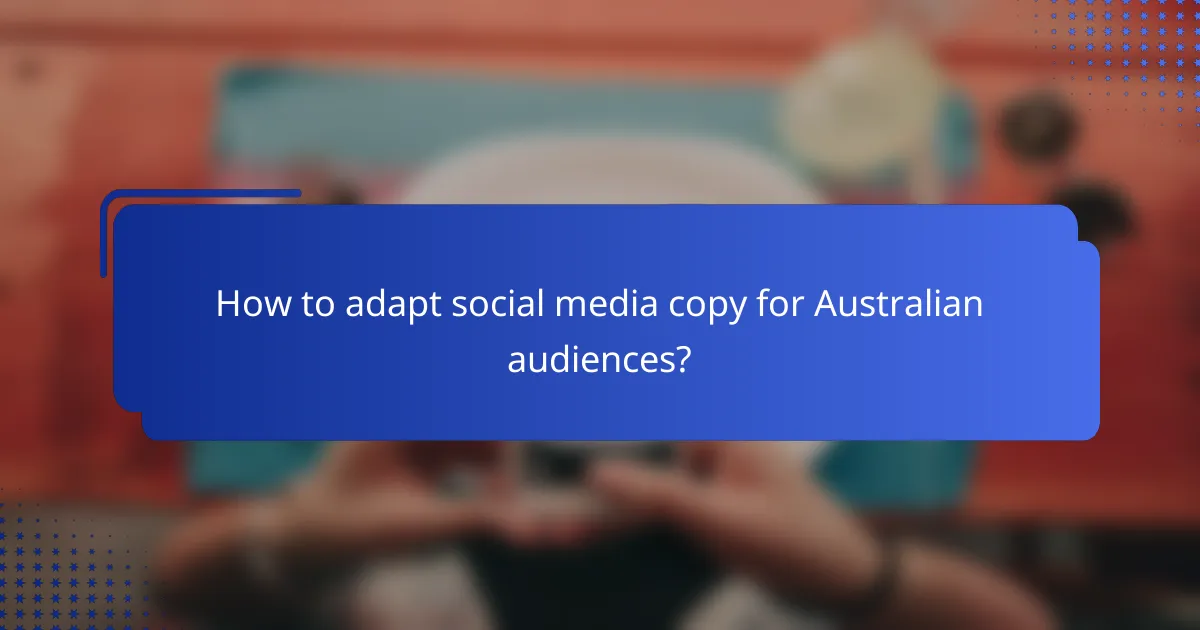
How to adapt social media copy for Australian audiences?
To effectively adapt social media copy for Australian audiences, focus on using local language, cultural references, and addressing issues relevant to the community. Understanding the unique characteristics of Australian culture will enhance engagement and relatability.
Use culturally relevant references
Incorporating culturally relevant references in your social media copy helps create a connection with Australian audiences. Use local slang, idioms, and references to popular Australian culture, such as sports, music, and food, to resonate with your followers.
For example, mentioning iconic Australian events like the AFL Grand Final or referencing popular local foods like Vegemite can enhance relatability. Avoid generic phrases that may not hold the same meaning or impact in the Australian context.
Address local issues and trends
Addressing local issues and trends in your social media copy is crucial for engaging Australian audiences. Stay informed about current events, social movements, and environmental concerns that matter to Australians, such as climate change or Indigenous rights.
For instance, if your brand supports sustainability, highlight your initiatives in reducing plastic waste, as this is a growing concern in Australia. Tailoring your messaging to reflect local priorities can significantly improve audience connection and brand loyalty.
